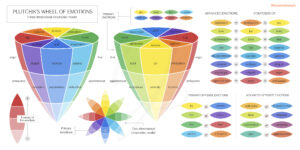Reaching new levels of relaxation using guided imagery - for stress and anxiety
The stress-reduction technique
What is guided imagery?
Guided imaging (also known as guided meditation, visualisation, mental rehearsal, and guided self-hypnosis) is a method that concentrates the mind in proactive, constructive ways. It may be as easy as a 5-second pause before jumping from the diving board, during which the athlete visualises how a great dive feels while slashing through the water. Or it may be as calming as visualising building a campfire while camping in the woods. Although visualising has been referred to as mental rehearsal and mental imagery, these labels are misleading. Guided imagery engages all the senses, not just the visual sense, which is advantageous since only 55% of the population is firmly wired visually, and it is experienced throughout the whole body, not just the mind. Also, it is sometimes referred to as self-hypnosis since it induces a hypnotic state of mind. Guided imagery is considered meditation, and many may use the terms interchangeably. This approach is very democratic in that it is accessible to almost everyone. It is an inclusive resource that transcends inequalities in education, class, colour, gender, vitality, culture, and age.
Guided imagery in clinical terms
In clinical terms, Guided imagery, also known as Guided Affective Imagery or (KIP) Katathym-imaginative Psychotherapy, is a form of mind-body intervention in which a trained practitioner or therapist assists a participant or patient in evoking and generating mental images that simulate or recreate the sensory perception. Sensory includes sights, sounds, tastes, smells, movements, and images associated with touches, such as texture, temperature, pressure, and imaginative or mental content that the participant chooses. Guided imagery may be done either one-on-one or in a group setting, with the practitioner or therapist acting as facilitator. Alternatively, the participant or patient may follow the instructions presented through a video, audio recording, or other audiovisual material that includes spoken instruction that may be accompanied by music or sound effects.
Both voluntary and involuntary processes can cause mental imagery. It is a simulation or recreation of perceptual experience across all sensory modalities, including olfactory imagery, gustatory imagery, haptic imagery, and motor imagery. However, visual and auditory mental pictures are considered the most often experienced by individuals in everyday life and controlled studies, with visual imagery being the most well-explored and recorded in scientific literature. In experimental and cognitive psychology, researchers have primarily focused on voluntarily and purposefully created imagery, which the participant or patient develops, inspects, and changes, such as by invoking imagery of a scary social occasion and changing it into pictures indicative of a pleasurable and affirming experience. In psychopathology, clinicians have usually focused on images that “come to mind” on their own. For example, a depressed person may have unwanted negative images that show sadness, hopelessness, and morbidity. Or, someone with posttraumatic stress disorder may have images that remind them of past upsetting events. In clinical practice and psychopathology, unwanted and unasked-for mental images that “hijack attention” in some way are called intrusive. The persistence or “keeping in mind” of imagery, whether intentional or involuntary, involves significant demands on cognitive attentional resources, including working memory, moving them away from a particular cognitive activity or general-purpose focus and towards the imagery. In clinical practice, guided imagery may advantageously exploit this process therapeutically by educating the participant or patient to concentrate attention on a considerably demanding activity, which effectively competes for and directs attention away from the uninvited intrusive imagery, so diminishing its intensity, vividness, and length, and thereby reducing discomfort or suffering.
Sometimes all we need is to take a step back, breath and visualize
( Joseph L. Wong )

Guided Imagery Challenges treated with Guided Imagery
The approach’s shown efficacy has attracted acceptance in recent years, although it was once seen as a supplementary or alternative strategy. Guided therapeutic imagery is now extensively used and backed by scientific evidence. The method is often used for stress management, with the therapist encouraging the patient to visualize a location that induces a calm sensation. According to research, guided imagery is effective in the therapy of a variety of issues, such as:
- Posttraumatic stress disorder
- Social anxiety
- Grief
- Depression
- Diminished self-care
- Bipolar disorder
- Family and parenting issues
- Stress
- Depression
- Substance abuse
- Relationship issues

Guided Imagery Benefits of using Guided Imagery
Physical Benefits
The stress response involves the release of adrenaline and cortisol. The pulse rate and blood pressure increase, the breathing becomes short and quick to hyperventilation, the body temperature increases, and so on. They endure a greater frequency of headaches, intestinal issues, chest pains, etc.
When mental imagery elicits a more favourable response, dangerous hormones that induce negative responses are not produced. The decrease in blood pressure reduces the possibility of a heart attack. Migraines are prevented from developing from moderate headaches.
The stomach relaxes, so there are no “butterflies” or stomach cramps, which aids the digestion process. Your patient’s appetite improves, enabling them to consume a nutritious meal. There is no hyperventilation since breathing becomes more regular. The brain functions better when it receives more oxygen.
- Quickly and effectively relaxes the body. Your body tightens in reaction to a perceived or actual threat when you are anxious. But when you imagine something peaceful, you remind your body that it’s safe, which calms it down.
- Improves sleep. You may eliminate distracting pre-sleep thoughts by engaging in a relaxing activity before bed. Guided imagery provides the mental space necessary to fall asleep quickly.
- Reduces your levels of stress hormones. Stress causes your body to release adrenaline and cortisol, which raises your heart rate and blood pressure. Guided imagery inhibits the release of these hormones by the brain.
Emotional Benefits
Exercises for emotional wellness are very beneficial. A study of women with fibromyalgia found that those who used imagery felt better about themselves and had less stress, pain, and tiredness.
If a person is always nervous, they may achieve calmness by immersing himself in quiet and serene imagery. If they feel gloomy, they might employ images and concentrate on something that will make them smile to improve their disposition. If they are fearful, they might concentrate on images that make them feel safe and comfortable.
- Temporarily improves symptoms of anxiety and depression. You may momentarily escape unpleasant thinking patterns connected with anxiety and sadness by concentrating on relaxing images. Guided imagery is not a permanent solution, but it may provide much-needed relief.
Other Benefits
We may use guided imagery meditation to achieve success. If someone is terrified of failing a necessary task, they might concentrate on the images. It will increase their confidence and improve their chances of success.
Professional athletes typically rely on images to enhance their performance to make that basket, pull weights, and kick field goals. A therapist may tailor the session to address the particular mood impeding life objectives.
It helps you stick to good habits. You can use guided imagery to picture the good things that will happen because of what you do. If you think a habit is good for you, you’ll be more likely to keep doing it.
Helps you feel less chronic pain. In 2015, researchers found that stressed people feel pain more than those who are not. If you have chronic pain, you can lessen its effects by relaxing with guided imagery.
Breath~
Bring yourself to a peaceful place
( Joseph L. Wong )

Guided Imagery How to do guided imagery meditation
A quiet place. Find a place where no one will disturb you. Set your devices to “do not disturb/silent” mode so that a ping won’t wake you up from a calm state. Your email & texts won’t be lost.
A place where you can sit or lie down in comfort. Make sure you can sit or lay down comfortably on the couch, bed, chair, or yoga mat. If you are sitting, do make sure you’re sitting reasonably straight.
An optional recording of guided imagery. On these recordings, someone walks you through the steps of guided imagery. You can find many of them on YouTube or through apps on your phone. If you still need to get used to guided imagery, this might help you get used to it and start practicing.
Headphones are optional. If you are listening to an audio recording, headphones can help you eliminate the external noise and get into the scene. You could also play soft music to keep yourself from being distracted by the outside world.
Now, here’s what you need to do to do guided imagery:
- In a quiet place, make yourself comfortable. You can sit or lie down.
- Close your eyes. Take a few deep, slow, long breaths. Keep breathing in this slow way for the rest of the meditation. (breathing 4-7-8 is beneficial here)
- Before you start your visualization, try to relax your muscles gradually.
- Make a mental picture of something in nature that makes you feel calm.
- Think about a lush forest, a beautiful mountain range, or a tropical beach. You could go to your safe space – place.
- Do pay attention to the specifics of the scene. Pay close attention to this safe place’s sounds, smells, and feelings. Become immersed in it.
- Observe the scene. Think about walking down a path. Pay attention to what’s around you as you walk.
- Take a few minutes to just chill out in your scene. Keep taking deep breaths.
- After 10 minutes, slowly open your eyes after counting to three.

Guided Imagery Standard script settings for guided imagery
A tropical beach setting
SEE: Visualize yourself lying on a beautiful beach all by yourself. Imagine being surrounded by soft, white, golden sand that is warm from the sun and crystal clear, warm turquoise blue water. Watch the gentle waves as they hit the beach. Imagine a blue sky with one or two soft, white, fluffy clouds up high. Back behind you, you can see palm trees moving in the breeze. Now, try to calm down even more.
SMELL: Take a deep breath and smell the sand warmed by the sun. Smell the salty, warm smell of the sea, which comes from the clear blue water. Take a deep breath and smell the rich, heady perfume of the tropical flowers on the palm trees. Now, try to calm down even more.
HEAR: Listen to the sound of the clear blue sea as the waves roll onto the beach and gently hit the sand. Listen to the soft breeze as it rustles the leaves of the palm trees behind you and moves the petals of the tropical flowers. Now, try to calm down even more.
FEEL: You can feel the warmth of the sun on your skin. Feel the soft breeze as it blows over your body and through your hair. You can stay here as long as you want and enjoy the experience and the vibe. Feel how calm and at ease you are. Enjoy how relaxed you feel as it spreads from your head to your toes. Notice how far away from worry and stress you feel. When you are ready, leave your magical place and return to the real world. Slowly count backward from 10, and when you reach 1, open your eyes. Take some time to get used to where you are before you get up.
Walking in the park setting
SEE: Imagine you are walking through a lovely green park. Think about how the different leaves on the trees move gently in the wind. As you walk by the flowers, look at their beautiful colours. Appreciate the droplets of dew that are still on the grass, making it look silvery. Imagine a blue sky with one or two soft, white, fluffy clouds up high. Now, try to calm down even more.
SMELL: Take a deep breath and enjoy the scent of the trees, the soil, and the freshly cut grass in the park around you. Please take a deep breath and smell the lovely floral scent of the growing flowers, which may still have dew on them. Now, try to calm down even more.
HEAR: Listen to the leaves rustling and the birds singing as they fly above you. Now, try to calm down even more.
FEEL: You can feel the sun’s warmth coming through the trees. You can hear the leaves on the trees rustling and feel the wind in your hair. You can stay here as long as you want and enjoy the experience and the vibe. Feel how calm and at ease you are. Enjoy how relaxed you feel as it spreads from your head to your toes. Notice how far away from worry and stress you feel. When you are ready, leave your magical place and return to the real world. Slowly count backwards from 10, and when you reach 1, open your eyes. Take some time to get used to where you are before you get up.
Open fire with snow outside setting (Country with four seasons)
SEE: Imagine sitting in a wood cabin on a soft rug in front of a roaring fire. Look at the snow on the windows, which makes the glass foggy, and the snowflakes fall outside. Think about how the fire’s flames change colours and flicker in the fireplace. Now, try to calm down even more.
SMELL: Take a deep breath and smell the wood fire in the fireplace. Enjoy the scent of fresh pine cones sitting next to the fire. Breathe in the smell of the new snow falling outside and feel how cold and crisp it is as it settles on the windows. Now, try to calm down even more.
HEAR: Listen to how quiet it is outside now that it has snowed. Listen to the wood crackling as the sticks in the fireplace are burned away by the fire. Now, try to calm down even more.
FEEL: Feel how cool the window is where the snow has made it foggy. Snuggle up in a big blanket and feel the warmth of the fire on your face and arms. You can stay here as long as you want and enjoy the experience and the vibe. Feel how calm and at ease you are. Enjoy how relaxed you feel as it spreads from your head to your toes. Notice how far away from worry and stress you feel.

Guided Imagery Open script guided imagery - Your safe space
Your safe space visualisation
Beginning :
To begin, I’d like to invite you to sit reasonably straight, relax your body, close your eyes and take a calm, deep breath — the deepest breath you’ve taken all day.
As you exhale, focus on the sound of my voice and allow it to ground you in the present now… Give yourself permission to focus on yourself right now and make yourself your top priority, there is nowhere else you needed to go and nothing else you need to be doing… For the next few minutes, your well-being will be your main concern…
Continue taking slow, deep breaths, allowing each inhales to be slightly deeper than the last… Feeling your lungs expand as you breathe in… Holding your breath for a beat and drawing it back in as you let it out… Repeat this breathing pattern with me as we travel through your safe space.
Now, take a moment to visualize a peaceful place and relax. this is your safe space.
For some, this might be in the comfort of your own home or a beautiful beach scenery; for others, it may be a place in the forest. …. Take a moment to recall this place…
Now I’ll guide you through the differences in your senses as you visualize your chosen safe space.
First, look around your safe space to see if anyone else is there. Family, friends, or even workmates
Think about what you might look like. You might be smiling, feeling happy, or just calm. What do you see in your safe space? What are you experiencing? Do you notice any of the objects’ colors, lighting, or textures?
Do you notice any pleasant smells? Perhaps the smell of the forest? The perfect family meal at home? Describe them in a few words to yourself. What do you experience through the sense of touch?
What is your skin in contact with, perhaps the sun? A breeze? a holding hand? What can you taste? What are you hearing? in your safe space.
Now, think about this safe space and remember every tiny details you noticed. & imagine that you’re painting your safe space on your canvas right now. Do you notice that your hands are moving as you paint? No matter what, you will always remember this special place.
End:
Enjoy this final moment there. Slowly walk backward and leave your safe space there. In 10 seconds, you’ll slowly open your eyes and feel great about yourself.

Guided Imagery Pros & Cons of guided imagery
What are the pros?
- It may induce a mood of calm, insight, and wisdom.
- With practice, you’ll be able to practice it almost any place.
- There are several free resources available online to help you get started.
- Mental imagery has no negative consequences on one’s health.
- It might assist you in releasing physical stress.
- It’s an effective diversion from psychological pressures.
- It may enhance your ability to tolerate chronic pain.
What are the cons?
It takes time to become proficient.
It might be expensive to work with a therapist, especially for individuals suffering from depression and PTSD. (but worth it)
Even though there are many free internet resources, it may be confusing and hard to get the complete picture of what type of guided imagery helps.
You may prefer different stress-reduction techniques.

Guided Imagery Conclusions
Final Thoughts About Guided Imagery
Guided imagery is a valuable technique for stress management and fostering better health. All that is required is a session with a therapist, who will provide direct supervision of your sessions. It is supported by sound or video records that may help the patient while they are at home. Once they have mastered the techniques, they may turn to guided imagery for anxiety anytime they feel stressed, unhappy, angry, or any other emotion that threatens to overwhelm them. Your patient may obtain excellent emotional health by soothing the mind, which transfers to better physical and mental health.
Limitation and Caution
While generally safe, guided imagery may occasionally cause uncomfortable feelings and put the patient in a precarious position. That’s why it’s crucial for a therapist who knows what they’re doing, respects therapeutic boundaries, and can handle unpleasant emotions to commence guided imagery in a healthcare context. Guided imagery is contraindicated mainly in people with PTSD since it may cause them to have flashbacks. Patients with severe OCD, delirium, or hallucinations are also not good candidates for treatment. Some patients, as is the case with any treatment, may not respond favorably or be able to conjure up a calming mental picture.

References
- Cocude, M., and Denis, M., Measuring the temporal characteristics of visual images. Journal of Mental Imagery, Vol. 12, No. 1, 1988, pp89–101. [14] Utay, J., & Miller, M. (2006).
- Complementary, Alternative, or Integrative Health: What’s In a Name? US Department of Health and Human Services. Public Health Service. National Institutes of Health. NIH Publication No. D347. Online Version. Retrieved 31 July 2015.
- Dobson, R.L, Bray, M.A., Kehle, T.J., Theodore, L.A., & Peck, H.L. (2005). Relaxation and guided imagery as an intervention for children with asthma. Psychology in the Schools, 42(7), 707-720.
- Foley KM, Back A, Bruera E, et al, eds. When the Focus is on Care: Palliative Care and Cancer. Atlanta, GA: American Cancer Society; 2005: p.176.
- Guided Imagery as an Effective Therapeutic Technique: A Brief Review of Its History and Efficacy Research. Journal of Instructional Psychology, 33(1). Retrieved from https://www.questia.com/library/journal/1G1-144014458/guided-imagery-as-an-effective-therapeutic-technique.
- Halpin LS, Speir AM, CapoBianco P, Barnett SD. Guided imagery in cardiac surgery. Outcomes Management. 2002; 6(3):132-137.
- http://acadgi.com/certificationtraining/index.html
- https://socialanxietyinstitute.org/what-is-social-anxiety
- http://www.guidedimagerydownloads.com/history-of-guided-imagery/#
- https://www.mayoclinic.org/diseases-conditions/post-traumatic-stress-disorder/symptoms-causes/syc-20355967
- https://www.nimh.nih.gov/health/topics/bipolar-disorder/index.shtml
- Hyman, I.E., & Pentland, J. (1996). The role of mental imagery in the creation of false childhood memories. Journal of Memory and Language, 35, 101-117.
- Ilacqua, G.E. (1994). Migraine headaches: Coping efficacy of guided imagery training. Headache: The Journal of Head and Face Pain, 34, 99–102.
- Kosslyn S. M., Ganis G., and Thompson W. L., Neural foundations of imagery. Nature Reviews Neuroscience, Vol. 2, No. 9, 2001, pp635–642.
- Leon-Pizarro C, Gich I, Barthe E, et al. A randomized trial of the effect of training in relaxation and guided imagery techniques in improving psychological and quality of life indices for gynecologic and breast brachytherapy patients. Psycho-Oncology.
- McAvinue, L. P., and Robertson, I. H., Measuring visual imagery ability: A review. Imagination, Cognition and Personality, Vol. 26, No. 3, 2007, pp191–211.
- McCaffrey R, Taylor N. Effective anxiety treatment prior to diagnostic cardiac catheterization. Holistic Nursing Practice. 2005; 19(2):70-73.
- Miller R. Nurses at community hospital welcome guided imagery tool. Dimensions Crit Care Nursing. 2003; 22(5):225-226.
- Naparstek B. Staying Well with Guided Imagery. New York, NY: Warner Books; 1994: pp.76-79.
- Rossman, M. (2010, August 18). Relaxation and imagery, meditation, and hypnosis–What’s the difference? Worry Solution: Using Breakthrough Brain Science to Turn Stress and Anxiety into Confidence and Happiness. Retrieved from http://worrysolution.com/2010/08/18/relaxation-and-imagery-meditation-and-hypnosis%E2%80%94what%E2%80%99s-the-difference
- Toth M, Wolsko PM, Foreman J, Davis RB, Delbanco T, Phillips RS. A pilot study for a randomized, controlled trial on the effects of guided imagery in hospitalized medical patients. J Alternative Complementary Med. 2007; 13(2):194-197.
- Tusek D, Church JM, Fazio V W. Guided imagery as a coping strategy for perioperative patients. AORN Journal. 1997; 66(4):644-649.

Scanxiety – Phases, Symptoms, and Coping with it

Reaching new levels of relaxation using guided imagery – for stress and anxiety

The Emotion Wheel: Everything to know

Coping with lung cancer

Deeper insight into what cancer patients feel
